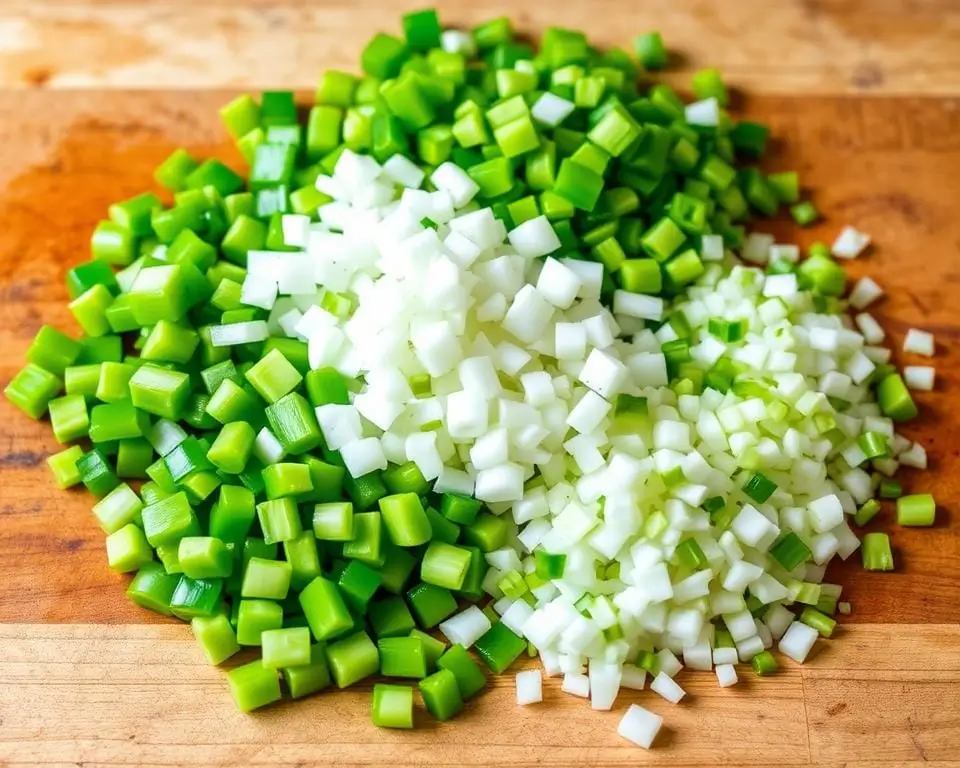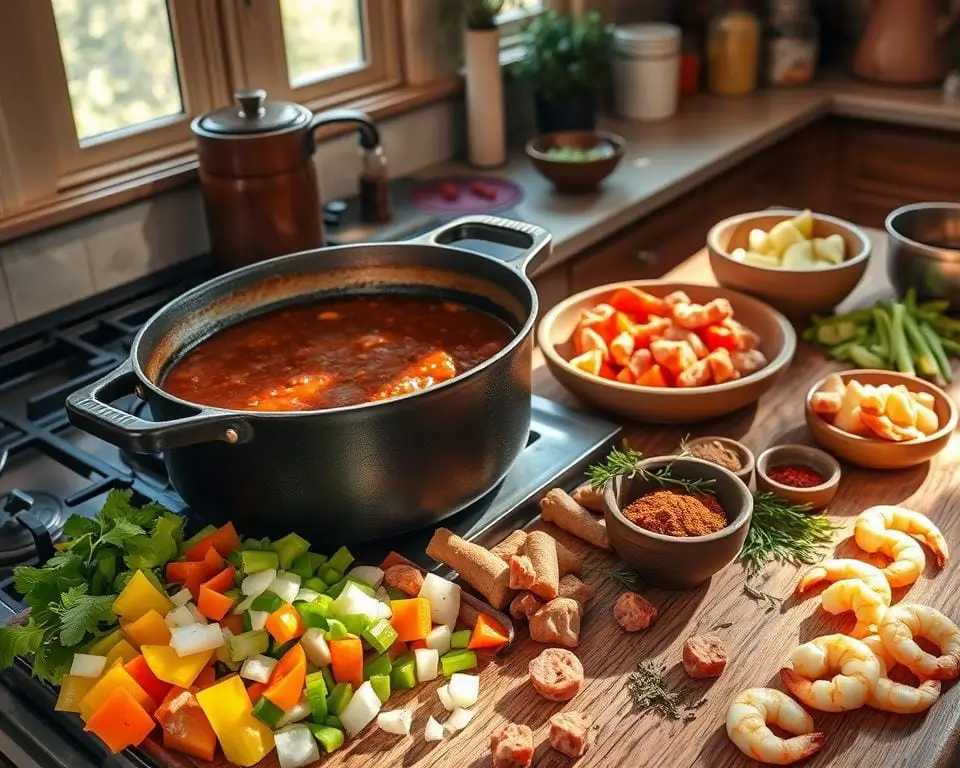Gumbo Recipe: How to Make an Authentic Cajun Gumbo at Home
Growing up in Louisiana, gumbo was more than a meal. It was a celebration of family, tradition, and rich culinary heritage. Every family gathering brought a steaming pot of this soul-warming Louisiana cuisine. The aromas could transport you directly to the heart of Cajun cooking.
Gumbo is not just a recipe; it’s a cultural experience that connects generations. Whether you’re a seasoned cook or a curious kitchen adventurer, mastering an authentic gumbo recipe opens a world of incredible flavors and time-honored cooking techniques.
This guide will show you how to make a true Cajun gumbo that captures the essence of South Louisiana’s most beloved dish. Get ready to transform your kitchen into a culinary paradise!
Table of Contents
Understanding the Rich Heritage of Cajun Gumbo
Gumbo is more than a meal; it’s a journey through Louisiana’s history. This dish is a mix of cultures that has shaped Southern food for years. Every spoonful of your Cajun gumbo tells a story of tradition.
The history of gumbo goes back to the 18th century. It was shaped by Native American, African, French, and Spanish traditions. These influences create the rich flavors of authentic Cajun gumbo.
Origins of Louisiana Gumbo
There are two main theories about the word “gumbo”:
- African term “kingombo” meaning okra
- Choctaw Indian word “kombo” referring to filé powder
What Makes Cajun Gumbo Different from Creole
Both Cajun and Creole gumbo come from Louisiana, but they’re different:
| Characteristic | Cajun Gumbo | Creole Gumbo |
|---|---|---|
| Tomatoes | Typically No | Often Included |
| Base Ingredients | Seafood, Fowl | Seafood, Vegetables |
| Cooking Style | Rustic, Rural | Urban, Refined |
Traditional Gumbo Variations
Your Cajun gumbo dish can have many tasty variations. Some favorites include:
- Seafood Gumbo: Full of shrimp, crab, and oysters
- Chicken and Sausage Gumbo: A hearty country-style gumbo
- Vegetable Gumbo: A lighter, plant-based option
“In Louisiana, gumbo isn’t just food – it’s a story told through flavor.” – Louisiana Chef Tradition
Essential Ingredients for Your Authentic gumbo cooking tips
Starting an authentic Cajun gumbo means picking the right ingredients. Your journey begins with knowing the key parts that make a simple dish into a Louisiana classic.
The heart of a great gumbo is in its ingredients. Let’s look at the must-haves that make your gumbo stand out:
- Flour and Oil for Roux
- All-purpose flour
- Vegetable or peanut oil
- Meats
- Andouille sausage
- Bone-in chicken thighs
- Optional seafood (shrimp, crab, oysters)
- The Holy Trinity
- Onions
- Bell peppers
- Celery
Cajun seasoning is key to making your gumbo taste like a true Louisiana dish. A good mix usually has:
| Spice | Purpose |
|---|---|
| Garlic Powder | Adds depth of flavor |
| Paprika | Provides warmth and color |
| Cayenne Pepper | Brings the signature heat |
| Dried Thyme | Contributes earthy undertones |
*”There are as many variations of gumbo as there are Louisianians”* – Chuck Taggart
Pro tip: Feel free to try new things with your gumbo. Add okra or black-eyed peas to tell your own story. And don’t hold back on the seasonings. A good amount of spice will give your gumbo that special Louisiana flavor.
Mastering the Dark Roux: The Foundation of Great Gumbo
The secret to a true Cajun gumbo is in the roux. This mix of oil and flour changes from light to a deep brown. This color gives gumbo its unique taste and depth.
Learning Cajun cooking starts with the roux. Chefs mix equal parts flour and oil slowly. This creates a base with a complex flavor.
Choosing the Right Oil and Flour
- Use neutral oils like vegetable or canola
- Select all-purpose flour for consistent results
- Opt for a heavy-bottomed cast iron pot or skillet
Achieving the Perfect Chocolate Color
Making a true roux takes patience. It cooks for about 45 minutes, turning from pale to a rich chocolate brown. This slow cooking adds deep, nutty flavors to Cajun gumbo.
“A great roux is the heart of any authentic gumbo” – Cajun Cooking Wisdom
Common Roux Mistakes to Avoid
- Never leave the roux unattended
- Stir constantly to prevent burning
- Remove from heat if black specks appear
- Maintain medium-low heat throughout cooking
Pro tip: Make a big batch of roux and keep it in the fridge. If you use vegetable oil, it lasts forever. This saves you time in your cooking.
The Holy Trinity: Preparing Your Cajun Vegetables

The Cajun Holy Trinity is a key part of Louisiana cooking. It’s a mix of vegetables that adds flavor to gumbo and other dishes. Unlike the French mirepoix, it gives a special twist to your cooking.
The core of the Cajun Holy Trinity includes three main vegetables:
- Onions (2 parts)
- Green bell peppers (1 part)
- Celery (1 part)
Chefs suggest using both red and green bell peppers for more flavor. The goal is to find the right mix of tastes that make your gumbo taste truly authentic.
“The Holy Trinity is not just ingredients, it’s a culinary tradition” – Chef Paul Prudhomme
Here are some important tips for making your Cajun Holy Trinity:
- Dice the vegetables the same size for even cooking
- Let the vegetables come to room temperature before adding to the roux
- Cook them until they start to soften
- Add garlic last to avoid burning it
Pro tip: Some New Orleans chefs see garlic as the “Pope” and consider it the fourth member of the Holy Trinity. Adding it can make your gumbo truly stand out.
Selecting and Preparing Your Meats
Making a great chicken gumbo or seafood gumbo begins with picking the right proteins. The choice of meat can make your gumbo go from good to amazing. It adds depth and rich Cajun flavors.
Choosing the Right Andouille Sausage
Andouille sausage is key in Cajun cooking. Look for brands like:
- Savoie’s Andouille
- Jacob’s World Famous Andouille
- Richard’s Mild Andouille
Preparing the Chicken
For the best chicken gumbo, use bone-in chicken thighs. They taste richer and are tender. If you’re in a hurry, a rotisserie chicken is a great choice.
Optional Seafood Additions
Adding seafood can make your gumbo even better. You can include:
- Fresh shrimp
- Lump crab meat
- Oysters
“The secret to an amazing gumbo is in the quality of your meats and how you prepare them.” – Cajun Cooking Traditions
| Meat Type | Best Preparation Method | Flavor Profile |
|---|---|---|
| Andouille Sausage | Slice and brown before adding | Spicy, smoky |
| Chicken Thighs | Brown, then simmer | Rich, tender |
| Seafood | Add last 10 minutes of cooking | Delicate, sweet |
Pro tip: Always brown your meats before adding them to the gumbo. It boosts their flavors and makes the dish more complex.
Step-by-Step authentic gumbo

Making an authentic Cajun authentic gumbo needs patience and care. This dish is a true taste of Louisiana, with its deep flavors and detailed steps.
Ingredients Preparation
- Prepare 1 pound Andouille sausage
- Season and chop chicken pieces
- Gather Holy Trinity vegetables (onions, celery, bell peppers)
- Measure spices and herbs
Cooking Process
- Brown Andouille sausage in a large pot
- Remove sausage, then brown seasoned chicken
- Create dark roux by whisking flour and oil
- Cook roux until chocolate-brown (12-15 minutes)
- Add Holy Trinity vegetables and sauté
- Slowly incorporate hot chicken broth
As you cook, your gumbo will get more flavorful. The dark roux is key. It should turn a deep caramel color for the best taste.
Final Touches
Simmer the gumbo uncovered for 30 minutes. Remove chicken, debone, chop, and return to the pot. Finish with fresh parsley, green onions, and adjust seasonings to taste.
| Cooking Detail | Specification |
|---|---|
| Yield | 4 servings |
| Prep Time | 20 minutes |
| Total Cook Time | 1 hour 20 minutes |
| Calories per Serving | 633 |
Pro tip: Serve your gumbo over white rice with a sprinkle of fresh green onions for an authentic Cajun dining experience.
“In Cajun cooking, patience is not just a virtue – it’s an ingredient.” – Louisiana Chef Wisdom
Seasoning Secrets for Authentic Cajun Flavor
Mastering seasoning is key to unlocking gumbo’s true essence. Your Cajun spices are what turn a simple stew into a masterpiece. This dish captures Louisiana’s rich food heritage.
To create the perfect gumbo seasoning, you need to balance flavors. The right mix of spices can take your dish from good to amazing.
Essential Spice Combinations
A classic Cajun spice blend includes:
- Garlic powder
- Onion powder
- Paprika
- Dried basil
- Dried oregano
- Dried thyme
- Salt
- Black pepper
- Cayenne pepper
“The secret to great gumbo is in the layers of flavor you build with your spices.” – Louisiana Cooking Tradition
Using Filé Powder and Bay Leaves
Two key ingredients in authentic Cajun gumbo are filé powder and bay leaves. Filé powder, made from ground sassafras leaves, is added after the gumbo cools. Bay leaves add a subtle depth to the flavor.
Remember to taste and adjust your Cajun spices as you cook. Each pinch can greatly impact the gumbo’s flavor.
Serving and Presentation Tips
Presenting your gumbo is an art that turns a tasty meal into a memorable experience. Serving your New Orleans Cajun gumbo right can make it stand out. It’s not just about putting the stew in a bowl.
Choose the right bowl for serving. A wide, shallow bowl lets the flavors pop. For a traditional touch, follow these tips:
- Start with a fluffy white rice bed in the bowl’s center
- Ladle the hot gumbo over the rice
- Add fresh herbs for color and taste
Adding traditional Louisiana sides can make your meal complete. Try these:
- Cajun-style potato salad
- Smothered green beans
- Homemade cornbread
“In Louisiana, we don’t just serve food; we create an experience.” – Chef Paul Prudhomme
Don’t forget the garnish. Top with finely chopped green onions and parsley. A sprinkle of filé powder adds a true New Orleans flavor.
Good presentation engages all senses. The colors, herbs, and arrangement make your gumbo a celebration of Cajun tradition.
Storage and Make-Ahead Instructions
Learning how to store gumbo can make it last longer. Your gumbo needs the right care to keep its flavors and textures. This way, you can enjoy it even after it’s been cooked.
Make-ahead gumbo is a great choice. It gets better with time, becoming even more flavorful. Making it ahead of time saves you time and gives you meals for the week.
Refrigerator Storage Guidelines
- Store gumbo in an airtight container
- Keep refrigerated for 3-4 days
- Store rice separately to prevent soggy texture
- Cool completely before refrigerating
Freezing Your Gumbo
Freezing is a great way to keep gumbo for a long time. Your chicken and sausage gumbo can stay frozen for up to 6 months.
| Storage Method | Duration | Best Practices |
|---|---|---|
| Refrigerator | 3-4 days | Use airtight container |
| Freezer | Up to 6 months | Use freezer-safe container |
Reheating Tips
Reheat your gumbo gently to keep its amazing taste. Use the stovetop on medium-low heat or microwave in short bursts, stirring often.
“A well-stored gumbo is like a fine wine – it only gets better with time!” – Cajun Cooking Wisdom
Pro tip: When freezing, divide large batches into smaller containers for faster cooling and safer food handling.
Conclusion
Making an authentic Cajun gumbo is more than just following a recipe. It’s about embracing a culinary tradition that runs deep in Louisiana’s cultural roots. Your journey through creating this rich, flavorful dish connects you to generations of passionate home cooks.
The art of making an authentic gumbo recipe requires patience, skill, and respect for Cajun cuisine. From carefully developing the dark roux to selecting premium ingredients like andouille sausage and fresh vegetables, each step adds to a complex flavor profile. Your dedication to understanding the nuances of this classic dish will shine through in every spoonful.
Remember, gumbo is a flexible recipe that welcomes personal interpretation while maintaining its core principles. Whether you choose duck, chicken, or seafood as your protein, the key is creating a deep, layered flavor that captures the essence of Louisiana’s culinary heritage. With practice, you’ll develop the intuition that transforms a good gumbo into an extraordinary meal that connects you to a rich cultural tradition.
By mastering this authentic gumbo dish, you’re not just preparing a meal. You’re preserving and celebrating a vibrant piece of Cajun cuisine that continues to inspire and delight food lovers across generations.

